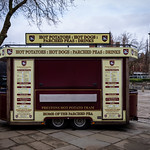- Preston City Council local elections 2024 candidates list set out
- Blog Preston reaches crowdfunding goal for expanded arts and culture coverage
- Harris Institute owners move to squash ‘for sale’ rumours
- “Unacceptable” and “must do better” as Preston records highest rough sleeper count since records began
- Preston Animate cinema reaches highest point in construction
Mystery of Prescott’s Court on student apartments construction site in Friargate
Posted on - 19th April, 2015 - 7:04pm | Author - Paul D. Swarbrick | Posted in - History, Observations, Photos, Preston City Centre, Preston Locations, Redevelopment
The part of Friargate featuring Preston’s ubiquitous Richard Bamber and Son Ltd., in which the demolition took place: Pic Preston Historical Society 1976
As most Prestonians will know, there has been a demolition of properties in an area on lower Friargate, to the north side of Great Shaw Street. The properties concerned in the demolition have been swept away to make way for a new development of student apartments being constructed by Eric Wright Group on behalf of Portergate Properties.
AdvertisementIt had been noticed that during the demolition work several interesting features had been uncovered below the existing ground level and the Archaeological Services, Durham University were called in to investigate these findings. A complete archaeological ‘dig’ ensued revealing an old well under what would have been the yard of a former terraced house on the north side Great Shaw Street extending up to Market Street west (both of these streets at one time were formerly known as Back Lane). The line of terraced houses extending from the junction of what was Back Lane and Friargate to where the premises latterly known as Blitz nightclub stood, were demolished many years ago to widen Great Shaw Street to enable easier traffic access. The grounds at the rear of what was Bamber’s Furniture yard revealed the footprints of various buildings that would have been built around the mid nineteenth century, along with furnaces and two reservoirs, one which would have been used by the nearby cotton mill.

An old well in what would have been the yard of one of the terraced house’s in Great Shaw Street (formerly Back Lane): Pic Preston Historical Society
It appears that in 1824, very little was built on this parcel of land as shown in the Baines Map 1824. When you then view the Myers Map 1836, you notice that a lot more has been built on the land and as time passes the land becomes more populated by houses, shops and industrial premises as indicated in the Ordinance Survey map of 1849 and 1890.

Extract from Baines Map 1824

Extract from Myers Map 1836

Extract from O.S. Map 1849

Extract from O.S. map 1890
From the Ordinance Survey map of 1890 extract above you will notice that within that area there is a section which was known as Prescott’s Court (later Prescott’s Yard). According to records, this was a very densely populated residential small area. Up to around 1871 many people residing in Prescott’s Court were involved in the cotton industry in one way or another and many were of Irish decent. This very small court appears to have eventually given up in some way to engineering and blacksmith industries and possibly laundering services.
According to Marmaduke Tulket in his book ‘History of the borough of Preston’, he states that the Back Lane Cotton Mill was built by a Mr Pearson and consisted of two buildings, one of stone and one of brick and was run by Firm of Messrs. Caton and Leche. In later years the cotton mill ceased to operate and subsequently was taken over by the firm John Cockshott and Co. Mill and General Brush Works. Towards the mid twentieth century the building became vacant and eventually was used as a nightclub premises and up to this year was still used as such apart from a short period of time when it was used as a Hydroponics store.

John Cockshott & Co. Market Street & Great Shaw Street, Preston. Note the terraced properties on the left, one of these houses will be where the well was discovered in the yard: Pic Preston Digital Archive

The Gatsby Nightclub, Great Shaw Street, Preston c.1989. One of the building’s various guises as a nightclub premises: Pic Preston Digital Archive
It would have been marvellous to spend longer on the demolition site to investigate further, but alas, we only had a window of an hour or so as the groundwork operations had to continue. Of course, the records investigation will be ongoing for some time to ascertain the exact uses of all the building which existed on the site and the people who used the various industrial and residential premises and for what purpose. Time will tell on this quest.
Worth noting is Prescott’s Court, that in later times became Tommony’s Yard, as it remained until demolition. Many Prestonians will recall the yard leading to ‘Guild Motors’, an engineering firm for many years. This can be seen in the image immediately below.

The site of what would have been a reservoir for the Back Lane Cotton Mill: Pic Preston Historical Society

Part of a metal barrel which was originally embedded into the ground and now almost fully decayed: Pic Preston Historical Society
You can view a slideshow of the set of images of the construction site from the Preston Historical Society Flickr gallery, below.
The photography and the research of the historical information has been compiled by Paul D. Swarbrick, Karen Doyle and Gillian Lawson of the Preston Historical Society and they would like to express their gratitude to Eric Wright Group and Portergate Properties for allowing the Preston Historical Society to be on site to enable them to create this historical account.
What do you think of the archaeological ‘dig’ images? Let us know in the comments below.
















 Advertisement
Advertisement